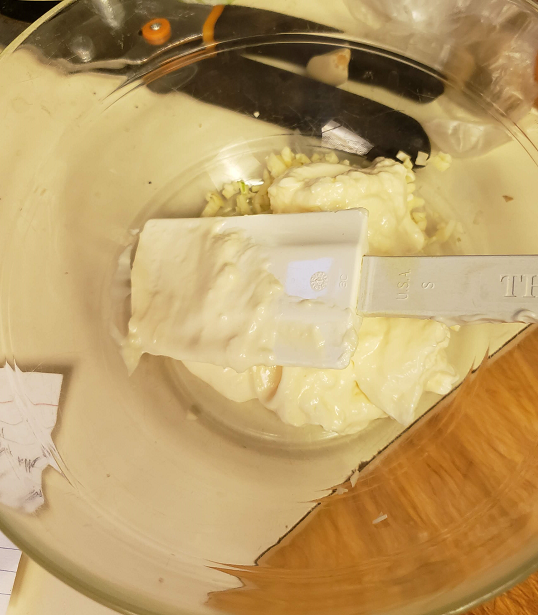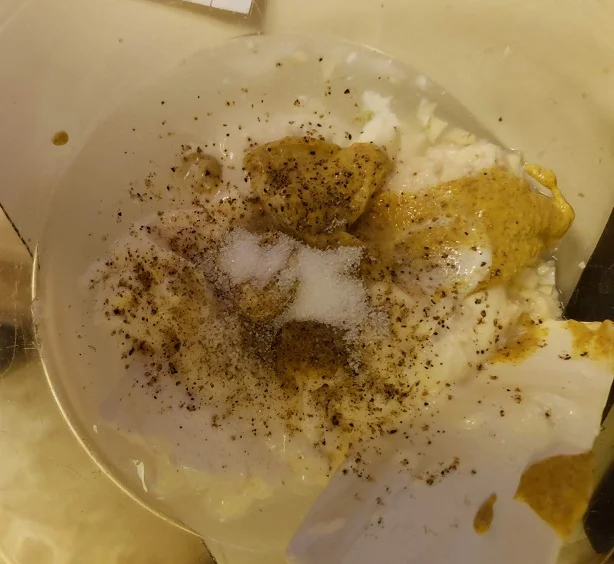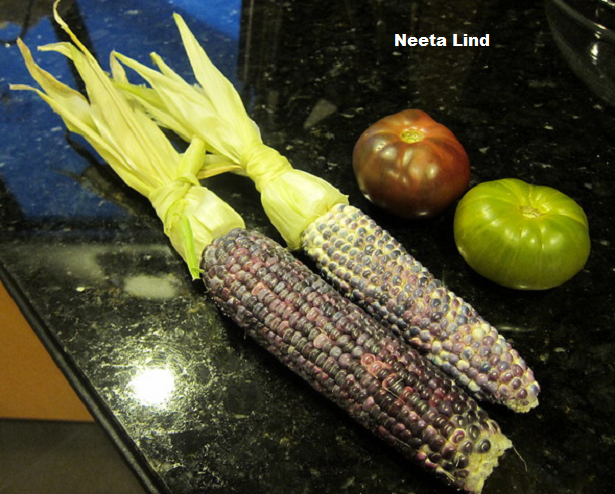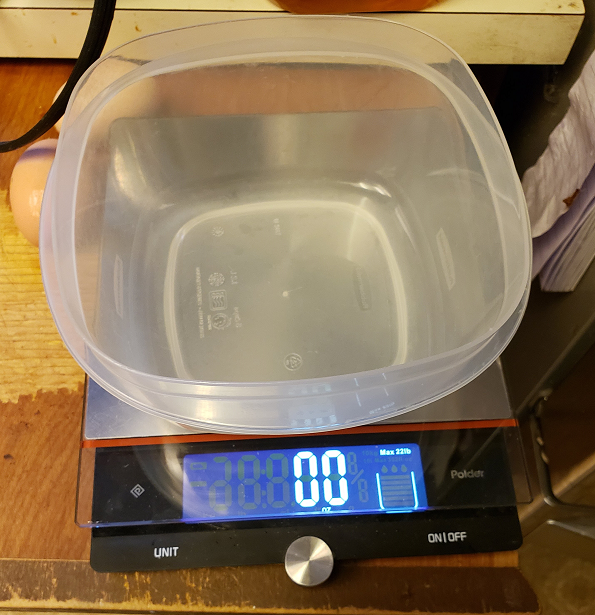KC 174 – Red, White, And Blue!

Why Hello there! And welcome, one and all, to Kitchen Catastrophes, where today’s topic is a patriotic platter of pigmented party parcels, as we gussy up some grub for the FOURTH OF JULY. Yes, America’s birthday (and my friend Jason’s, natch) is coming up this Thursday, and in the spirit of that special day, I made a trio of recipes to color your picnic table. So let’s dish on what’s on our dishes. If you wanna skip, here’s the link.
OH SAY CAN YOU SEE
Fun fact, legally, the entire idea of the 4th of July is built on a (slightly) flawed premise. We actually voted to leave England on July SECOND. While the The Declaration of Independence, drawn up on the 4th, is like, the press-briefing about the vote, and it wasn’t even signed by many delegates until August. Little historical tidbit there. Anyway, we’ve been celebrating the 4th for a LONG time. Literally, the first recorded 4th of July party was July 4th, 1777. Literally the NEXT year. Though, it didn’t become an official federal holiday until 1870; which sounds like a long time, but you have to understand: that was when we invented the CONCEPT of federal holidays. The Fourth of July is tied for the longest-standing federal holiday with Christmas, New Year’s, and Thanksgiving. (Though, Thanksgiving was pinned down as a federally APPROVED holiday before that, in 1863, by Abraham Lincoln, it wasn’t legally recognized until 1870, when Congress signed a law letting all federal workers stay home those days.)
It is a holiday surprisingly celebrated in almost exactly the way the Founding Fathers intended: John Adams, writing of the 2nd of July, noted that it should mark a magnificent epoch of history, and should be commemorated with pomp and parade, feasting, bonfires, guns and bells, music, dance, and illuminations. (Guns here refers to the idea of the “X Gun Salute”, and ceremonial cannon-fire, while “illuminations” was the name for fireworks at the time.) And…Yeah, we do most of that; Bonfires not so much in most of the country (July’s a pretty dry month, few too many accidents) but other than that (and the date, again), we’re pretty on point.
Is this not pomp enough for you?
And given my family’s pseudo-military roots (my father, my mother, and my father’s father were or are employees of the Department of Defense), and our strong connection with Americana (my brothers and myself are all three Eagle Scouts) it should come as little surprise that, for most of my youth, 4th of July was a big deal…in a weirdly small way. Like, in recollection, I can only pin down ONE recurring tradition: that of the Cul-de-sac Fireworks. Like, we didn’t GO anywhere unless we hadn’t gotten ahold of enough fireworks yet, and I don’t recall that we always did burgers or anything. (we may have done so, and I simply never noticed, as it wasn’t uncommon for leisure days in the summer to mean burgers)
In any case, I wished to honor that memory with a big demonstration, and ran, rather quickly into an issue: You can find plenty of white and red foods, sure. But blue’s trickier. It’s not really a color you see in natural products. And sure, I could just add food coloring to a dish to make it blue, but, if there’s one thing I learned from Big Trouble in Little China, it’s that “It’s all in the Reflexes”. If there’s TWO things I learned from Big Trouble in Little China, it’s that “The Chinese have many Hells”, and after a couple more excellent quotes from an utterly insane 80’s triumph, somewhere around the 6th or 7th thing I learned is Wang Chi’s surprisingly patriotic toast: “Here’s to the Army and the Navy, and the battles that they’ve won. Here’s to America’s colors, the colors than never run.” Which, I mean, eat a dick Marines and Air Force, but I think it explains why I couldn’t use blue food dye to make my blue food. Which made this process interestingly frustrating. Because I IMMEDIATELY locked onto the “Red” and “White” I wanted to make.
Red, The Blood of Spicy Men
I knew I wanted to do salsa roja for the “red”, for a variety of reasons. One, because it gave me a perverse pleasure to start off something so patriotically American with a dish named in Spanish. My own little twist on pandering high-school Spanish rattled out on the debate stage, you could consider it. Secondly, because I like the idea of the names reflecting their roles, and this was the most mainstream option I could find. By which I mean I wanted each dish to not just be the color, but use the color in the name, and while I like Red Beans and Rice, it’s not typical picnic food in my area. Nor is Red-Red, Redfish, or Red Wine (which I really did NOT have time to make). But salsa? That’s something that shows up all the time at cookouts in my area, and salsa roja is a fine opportunity to make something interesting.
Could I have made red-candy? Probably, but if there’s one thing I’ve learned, it’s that making candy shells can be much harder than it seems.
Now, if you don’t speak Spanish, or aren’t aware of its cooking styles, a little warning: this is A salsa roja recipe, not THE Salsa Roja recipe. Because, translated, salsa roja just means “red sauce”, and that term is used for just a broad swathe of options as it is in Italian-American homes. I’ve seen recipes with chile de arbol, recipes with charred poblanos, as long as the resulting mixture is red, and can be served with Mexican food, it’s a salsa roja. I’m going with a relatively unusual recipe, glancing over the various ones I’ve seen, partly because it comes from Claire Saffitz of Bon Appetit, and yes I WILL keep pushing you all to watch her emotional breakdowns as she tries to make candy bars, and partly because I felt it moved a little closer to the kind of things we as Americans expect at a barbecue: This recipe (Smoky Salsa Roja), calls for chipotle peppers, garlic, tomato paste, AND apple cider vinegar and molasses. And with those last two ingredients, it moves intriguingly toward a “barbecue sauce profile. (Specifically a Kansas-City style barbecue sauce, which is, for various reasons, what most people think of when they think of barbecue sauce. We’ll touch on that complexity in a minute.)
And this recipe is pretty direct. You soften a chopped onion and some chopped garlic, get a little color on them, and then add tomato paste and chipotle pepper with adobo sauce. That’s just the sauce you pack canned chipotles in, it has almost nothing to do with Adobo sauce from Chicken Adobo. As we cover there and in a recently uploaded video for our Patreon supporters, Adobo refers to a lot of things, because it was the Spanish word for “marinade” for a couple centuries. Then you toss in a can of fire-roasted tomatoes, and cook out some of the liquid.
Not this much. This is BEFORE the tomatoes go in. I forgot when my pictures were taken.
Now, the original recipe says “let cool, then blend”, but because I’m REALLY bad at time management, I actually had to pop this stuff into the fridge at this point, because it was 10 o’clock, and it’d be a shitty move to use a blender 30 feet from my family an hour after they call it a night. (And people say I’m a tactless asshole! …Which isn’t to say they aren’t right, merely that I’m not ALWAYS one.) Thus, I popped that sucker in the fridge overnight, and pulled it out this morning.
Chunky looking, and chipotle-totin’.
Honestly, if you just wanted like, a chunky kind of salsa, this isn’t TOO far off. It’s lacking in acid, so you’d want to hit it with some lime juice, maybe a little extra diced onion for a fresher crunch, balance it with some salt and a dash of pepper, but flavor-wise, there’s a solid base. Which is why I found the next parts so interesting. A quarter cup of apple cider vinegar, which, sure, is going to solve the acid problem, and a tablespoon of molasses. The molasses in particular was interesting. Sweetness AND bitterness, it’s a secret weapon in several recipes, but I didn’t really see much of a need for either of those elements in a salsa. But, hey, recipe needs what it needs. Pour the salsa base, vinegar, and molasses into a blend for the very scientific “until the streaks of molasses go away”, and try it. Now, the recipe from Bon Appetit goes “until smooth, and their finished product seriously looks like a thick ketchup, they’ve blended it so well. Which is fine for a sauce on meat or tacos, but I wanted something that could, if desired, be dipped on a chip, so I stopped early.
And it’s…certainly interesting. I’m still waiting on the flavors to meld, but there’s already a complexity and depth of flavor to it that I like. The ACV’s a little strong in the beginning, but I used a pretty strong variety, so that’s probably on me. Overall, I liked where it was, and hope I’ll like it more when things get to know each other a little better.
Which let me move onto the white!
Bum-Bum bum-buh-Num, bum-buh buh-Num, Bum-bum bum-buh-Num, The White Stuff.
I also immediately latched onto an idea for the white component: White Barbecue Sauce. As we just addressed (and talked more broadly about last year), there are multiple varieties of barbecue, and therefore barbecue SAUCE, in America. Kansas-City uses a sweet, thick sauce, Texas uses a thin and spicy, North Carolina uses a Mustard base, etc. (this is in part because each region uses different cuts of meat, that want different accompaniment. Texas is brisket country, with fall-apart fatty beef, so something to cut that is wanted. North Carolina uses Pork, which is ALSO rich and fatty by nature, so they want a more nasal-clearing spice. Kansas-City is more general, but prides itself, among options, with ribs, where the tactile sensation of holding and eating is part of the experience, so a thicker sauce that sticks to fingers is more pleasing.) In Alabama, ONE specific business, and in fact, one MAN, “Big” Bob Gibson, birthed white barbecue sauce: he was using vinegar/mustard based sauces for his pork shoulders, but he was ALSO cooking whole chickens. So he needed a variant of the mustard sauce that added in some more fat, to keep the chicken moist over the cooking time. Hence, the basis of the sauce, mayonnaise.
A sticky, svelte base.
I wanted to hit this recipe because A, it’s a relatively little known barbecue style, and B, it’s super fucking easy to make. The recipe is literally just “assemble the components, and whisk together”. Which makes sense: it was invented by a man backyard barbecuing who THEN opened a restaurant. It wasn’t designed to be fancy and impressive, it was something he whipped together from what he had at home, and made it work.
The mixture of ingredients basically revolves around a couple key ingredients: mayo, of course; vinegar, since, again, this is basically a modified mustard-vinegar sauce (though I do see recipes that replace it with lemon juice); also, a touch of mustard, to help meld and add a little spice; horseradish, for a little more kick to cut through the mayo fat; and spices. I’ve seen several mixtures: black pepper and salt are the constants, but I’ve seen paprika, white and brown sugar, garlic powder, onion powder, cayenne, you name it. Some recipes call for Worchestershire, some call for hot sauce. My mix up (and this is very much a basic first draft sort of deal) is sugar, salt, pepper, paprika, with mayo, vinegar, brown mustard and horseradish.
This is…certainly something that’s happening.
Once you whisk all that together, you just got to let it meld together a little bit.
And…honestly, it’s not bad, but it’s not super impressive either. Nate and I were bandying about things it tasted like after he made it (oh, yeah, I was busy making the salsa roja and finishing our last component). And our consensus was it could use a little more kick (our horseradish is on the older side, and our ingredient balance might have been off, as we had JUST not quite enough mayo. Like, 7/8ths of a cup. So Nate tried to eye-ball everything else.) But it tastes like…”fry sauce”, or “ the special burger sauce at a diner”, or “Like if you couldn’t afford Parmesan for your Caesar salad dressing”.
Behold, the visual spectacle of mostly white sauce.
It’s by no means BAD, again, it’s just…odd, and sufficiently different that we didn’t really know if this was a success or not. But once we had the red and white down, it was time to tackle the Blue. And let me tell you, we found a DOOZY.
Anybody Remember TBS’s “Dinner and A Movie” series? They’d show a movie, and have a themed dinner plan to go with it?
Title Jon asks because, for DECADES since that show’s been off the air, I still sing the theme song for it sometimes while cooking. And that’s relevant because it was Louis Jordan and his Tympany Five’s “Beans and Cornbread”. Yes, for our blue component, we’re making blue cornbread.
Which, if you’re unaware, is NOT a cop-out given my earlier comments about dying foods. No, because, you see, there’s actually naturally blue corn
Well, “blue". It goes from blue to purple, and so on.
You’ve most likely seen it in more “healthy” tortilla chips, with “blue corn” options tending to show up in the organic or health-food sections. That’s because blue corn has more protein than normal corn, which helps balance the natural sugar load to reduce its glycemic index. (That means it doesn’t cause your blood sugar to spike as much, which is great for diabetics.)
It actually tends to TASTE a little sweeter than normal corn, which makes a great candidate for cornbread if you like it sweeter, as I do. The recipe is a pretty standard cornbread recipe, as long as you can get your hands on the blue cornmeal you’ll need for it.
Which looks like weird sand.
Just cream some butter and sugar, and make two mixes. One will be the liquid mix, combining several large eggs and milk into a…what? What do you mean we don’t have MILK? It’s a STAPLE FOOD of the American kitchen! It’s an ingredient in like, HALF of all baked goods! Well I’M NOT GOING TO GO BUY IT. Fuck. Alright. This is actually fixable. See, as you almost certainly don’t recall from our Chicken Skin Buns post, while we may not have actual milk lying around, we DO have milk POWDER. So I’ll just…make my milk for the recipe.
This is not something I’ve ever had to do before. Which is probably some kind of privilege.
Whisk that with some eggs, and make the flour. Now, interestingly, the recipe I found gave both volumetric measurements for the flour and cornmeal, AND weight-based metrics. And, if you watch baking programs at all, you’ve almost certainly heard the constant refrain: “measuring by weight is more accurate”. So I decided to do so for this recipe. We have a nice little food scale, which cost somewhere between $20-60, depending on which one you get, and if it’s on sale. We mostly use it to weigh one of our chickens (she has a condition that causes her to swell up, and she lost a lot of weight getting over a couple bouts with it, so we’ve been doing daily health-checks) or wood blocks for craft projects, but a quick sanitizing, and it’s ready to weigh food.
Behold the Scales of Taste-us.
Flour, cornmeal, salt and baking soda get mixed together, and then you do a kinda fun “layering” system of adding the ingredients to the creamed butter: First you add 1/3rd of the flour mix, then half the egg-milk, then another 1/3rd, the other half, the last 1/3rd, keeping the beaters mixing while you add everything, to get it fully combined before the next batch. Keep it on the LOWEST setting, as even increasing it to a 2 caused our machine to fling egg-milk out to land in a rather embarrassing position on my pants.
Which were already fairly embarrassing.
But once it’s all mixed, it’ll look like… well, kinda like concrete before it sets.
It’s certainly not the most appealing mixture.
But pop that in the oven for 22-25 minutes, and do the other recipes while it cooks. Oh, yeah, you should start this one first. Did I not mention that? Shucks. Anyway, while we wait, I’ll note that while it might SEEM hard to get blue cornmeal, I’ve heard from many sources that, depending on where you live, Wal-mart might have it, or local Mexican grocery stores. And if nothing else, you could order it from Amazon. With Prime delivery, we ordered ours on Thursday, and had it Saturday. If you don’t have amazon prime, you could just make cornbread and add blue food dye, or, really, make like, a blue cocktail. Because, if you hadn’t noticed until now, none of these are main courses: we figured you’d be doing some kind of grilled meat (or grilled veggie) for the main course, so we wanted to keep our colorful contributions on the side: a dipping sauce, a sauce for mains, and a drink or starch. The accoutrements, not the entrée. We’re thoughtful like that.
Anyway, the bread’s done now.
LOOK AT IT. LOOK AT IT WHILE I HOLD IT TOO CLOSE TO YOUR EYES.
The top will be like, aggressive brown (at least mine was), but inside, it’ll be a kind of pale blue, with streaks of deeper blue. It’s more than a little pretty. Flavor-wise, it doesn’t taste super different from any other cornbread I can think of. It’s a good cornbread, solid and sweet, not dry and crumbly.
And there you go, Roja, White, and Blue, from us to you.
fanfare and explosions
Try some or all of these recipes out for your independence day. If you’re Canadian, skip the cornbread and make the other two RIGHT NOW for a weird set of side for Canada Day! (Do you guys do that? Like, have barbecues for Canada Day? I don’t know. Yours is a mysterious and fascinating culture.) In any case, I’m gonna go…not sleep, but probably harass some chickens and watch some Youtube, to prep for a week of explosions. (Because, while it’s only legal to set-off fireworks on the 4th itself, plenty of people set them off all week, with the expectation that unless you’re RIGHT THERE and see, it’s hard to know who set off what, so the cops can’t get you.)
Help me order more colorful ingredients for the site by backing us on Patreon! Or share our message and posts on social media! We’re on Facebook, Twitter, and Instagram!
THURSDAY: IT’S A FEDERAL HOLIDAY, CAN’T A GUY CATCH A BREAK? (SERIOUSLY, I MAY TAKE THE DAY OFF, I MAY NOT. I DON’T HAVE ANY BIG IDEA FOR IT RIGHT NOW, SO IT’LL DEPEND IF SOMETHING INSPIRES ME)
MONDAY: JON TAKES A TWIST ON A CLASSIC AMERICAN BARBECUE FOOD FROM SEVERAL THOUSAND MILES AWAY, AND DELIVERS IT TO YOUR DOOR. WELL, HIS DOOR. YOUR DOOR’S A LITTLE FAR FOR HIM.
Recipes
Smoky Salsa Roja
Ingredients
2 tbsp olive oil
1 onion, chopped
2 garlic cloves, chopped
2 tbsp tomato paste
1 chipotle pepper in adobo sauce (chopped) +1 tsp adobo sauce
1 14.5 oz can diced fire-roasted tomatoes
¼ cup apple cider vinegar
1 tbsp dark molasses
Preparation
Heat the olive oil over medium-high heat. Add the chopped onion and garlic, cooking until onion is translucent and edges are browned (the original recipe says almost 8 minutes, but mine took like, 3-4 minutes). Add the tomato paste and chipotle pepper with adobo. Stir to combine and cook an additional 3 minutes, until darkened. Add tomatoes, and cook an additional 5 minutes.
Let cool, and blend with vinegar and molasses. Serve with…whatever you want to top.
White Barbecue Sauce
Ingredients
1 cup mayonnaise
¼ cup white vinegar
2 tsps cream/prepared horseradish
1 tbsp spicy brown mustard
2 garlic cloves, minced
1 tsp salt
1 tsp sugar
1 tsp pepper
¼ tsp paprika
Preparation
Whisk all ingredients together, and allow flavors to meld for at least 30 minutes. Use within 1 week.
Blue Cornbread
Ingredients
1 cup white sugar
¾ cup butter, room temperature
1 cup milk
3 extra-large eggs
10 oz all-purpose flour (2 cups)
5 oz blue cornmeal (1 cup)
4.5 tsps baking soda
1 tsp sea salt
Preparation
In the bowl of a stand mixer (or using a hand mixer, in a large bowl), cream together the butter and sugar. Preheat your oven to 400 degrees.
Combine in one bowl the eggs and milk, and the remaining ingredients in another bowl.
Turn the mixer on at slow speed. With the mixer running, add 1/3rd of the flour mixture to the mixture, and allow to combine. Add ½ the milk mixture, and allow to combine. Repeat with remaining 1/3rd flour, ½ milk, and 1/3rd flour, waiting between each addition.
Grease a 9” x 13” pan, add the formed dough, and spread evenly. Bake for 22-25 minutes, until a tester/toothpick inserted into the center of the pan comes out clean.




















